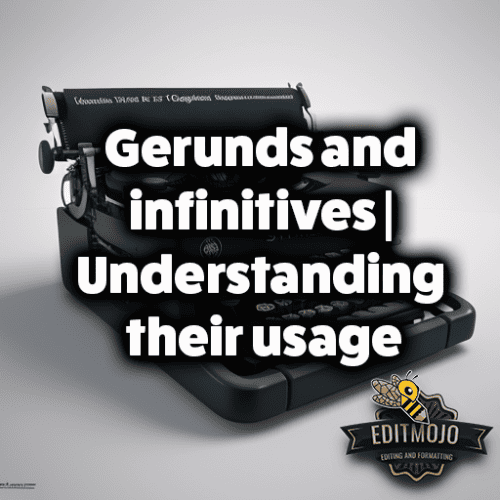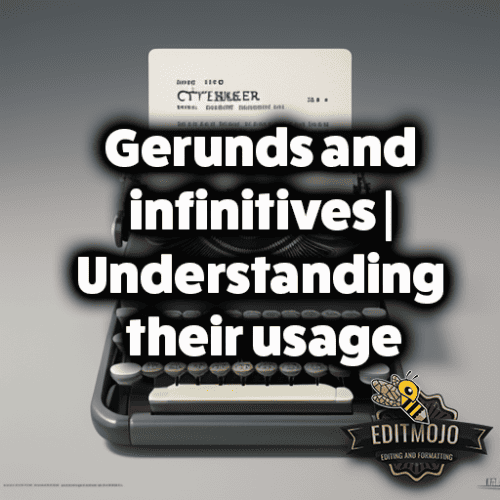Gerunds and infinitives | Understanding their usage
Gerunds and infinitives | Understanding their usage. Imagine being a painter with an array of colors at your disposal but limited knowledge about how to mix and blend them to create a striking masterpiece. This analogy applies directly to the art of language mastery. Today, we’re going to explore two essential “colors” in the English language palette: gerunds and infinitives. These verb forms offer numerous expressive possibilities and learning to use them correctly significantly enhances our linguistic artistry. Let’s dive right in.
Key Takeaways
| Gerunds | Infinitives |
|---|---|
| A gerund is a verb that ends with “-ing” and functions as a noun in a sentence. | An infinitive is the base form of a verb, often preceded by “to”. |
| Gerunds can be used as subjects, objects, after prepositions, and in compound nouns. | Infinitives can be used as subjects, objects, to express purpose, and after certain adjectives. |
| It’s essential to know which verbs are followed by gerunds. | It’s important to know which verbs are followed by infinitives. |
| Common error: Confusing gerunds with present participles. | Common error: Using an infinitive when a gerund is required, and vice versa. |
| Gerunds often appear in informal English. | Infinitives often appear in formal English. |
Understanding Gerunds (grammar)
What is a Gerund?
Put simply, a gerund is a verb ending in “-ing” that functions as a noun in a sentence. It’s a chameleon of sorts – it looks like a verb, walks like a verb, but in the world of grammar, it identifies as a noun. Let’s look at an example to illustrate this: In the sentence, “Running is my favorite pastime,” “running” is the gerund, operating as a noun that refers to the action of running.

Identifying Gerunds in a Sentence
Gerunds can appear anywhere in a sentence where a noun typically fits. For instance, they can be subjects, as in “Swimming keeps me fit,” or they can function as objects, like in “I enjoy swimming.”
Uses of Gerunds
Here’s where things get interesting. Gerunds are quite versatile and can pop up in various parts of a sentence.
- Gerunds as Subjects: Like in the previous example, “Swimming keeps me fit,” the gerund “Swimming” takes the central role in the sentence.
- Gerunds as Objects: After certain verbs, we can use a gerund. For example, “I hate washing dishes.” Washing is the gerund here.
- Gerunds After Prepositions: Whenever a preposition (in, at, for, etc.) comes before a verb, that verb must be in gerund form, such as “I am good at dancing.”
- Gerunds in Compound Nouns: We also use gerunds in compound nouns like “swimming pool” or “dancing class.”
However, the common mistake learners often make is confusing gerunds with present participles, as they both end in “-ing.” The key to distinguishing them is usage: gerunds function as nouns, while present participles function as verbs or adjectives.
Understanding Infinitives
What is an Infinitive?
An infinitive is the base form of a verb, often preceded by “to”, as in “to run,” “to eat,” or “to dance”. There are two types of infinitives: full infinitives (with “to”) and bare infinitives (without “to”).

Identifying Infinitives in a Sentence
Like gerunds, infinitives can also occupy various places in a sentence. They can appear as the subject, like in “To read is to travel,” or as an object, as in “I want to read.”
Uses of Infinitives
Let’s explore the exciting ways we use infinitives in English:
- Infinitives as Subjects: “To travel is to live.” In this sentence, “to travel” is the subject.
- Infinitives as Objects: After certain verbs, we use the infinitive form of the verb. For instance, “I decided to study.”
- Infinitives to Express Purpose: Infinitives are used to express the purpose or the reason why something happens. For example, “She saved money to buy a car.”
- Infinitives After Certain Adjectives: We use infinitives after certain adjectives, like in “I am eager to learn.”
However, one common error is using an infinitive when a gerund is required, and vice versa. It’s essential to understand which verbs require a gerund and which ones need an infinitive.
Gerunds and Infinitives in Context
When it comes to the question of whether to use a gerund or an infinitive, context is king. Some verbs require a gerund, some an infinitive, and some can take both with a difference in meaning.
For example, “I stopped smoking” (meaning you quit smoking) is different from “I stopped to smoke” (meaning you paused your activity to smoke). Learning which verbs are followed by gerunds and which are followed by infinitives can make a world of difference in your English proficiency.
It’s also worth noting that while there is generally a preference for using gerunds in informal English and infinitives in formal English, both forms are used in both contexts. However, overuse of one form can result in a text sounding too formal or too casual.

Practice Exercises
Time to flex your grammatical muscles with some practice exercises! You can find some interactive quizzes and exercises online. Practice spotting mistakes with gerunds and infinitives in sentences. Remember, practice makes perfect!
Tips and Tricks for Remembering When to Use Gerunds and Infinitives
- Mnemonic Devices: These are strategies that help you remember information. For example, remember that verbs of sensation (feel, hear, see) are followed by bare infinitives, while verbs of perception (like, love, hate) are followed by gerunds.
- Context Clues: If a verb is followed by a preposition, you’ll need a gerund. If it expresses purpose, you’ll need an infinitive.
- Simplify Complex Grammar Rules: Break down rules into manageable chunks. Make cheat sheets, flashcards, or use a grammar app.
The Impact of Correct Usage of Gerunds and Infinitives on Communication
Correct usage of gerunds and infinitives can significantly improve your comprehension and expression in English. You’ll be able to understand texts and conversations better and express yourself more clearly and precisely. Moreover, mastering gerunds and infinitives allows for more nuanced expressions, enhancing the richness of your English language skills.
Advanced Topics (Gerunds and infinitives | Understanding their usage)
For those ready to take their gerund and infinitive knowledge to the next level, consider exploring how they function in passive voice or how they are used in non-native English varieties. The discussion on split infinitives – should we or shouldn’t we split infinitives – is another fascinating topic to delve into.
Conclusion (Gerunds and infinitives | Understanding their usage)
English language mastery is an ongoing journey. Understanding gerunds and infinitives is like learning to blend colors; it adds depth and nuance to your expressive capabilities. Keep practicing and exploring the language with a curious and open mind. Remember, every expert was once a beginner.
For further study, check out Cambridge Grammar of English, and Penguin Guide to Punctuation among others. Happy learning!
Top Five Questions and Answers
| Questions | Answers |
|---|---|
| What is a gerund? | A gerund is a verb ending in “-ing” that functions as a noun in a sentence. |
| How is an infinitive different from a gerund? | An infinitive is the base form of a verb, often preceded by “to”, while a gerund is a verb ending in “-ing” acting as a noun. |
| Can a gerund be used as a subject in a sentence? | Yes, a gerund can function as a subject. For example, “Running is my favorite activity.” |
| Can an infinitive express purpose in a sentence? | Yes, an infinitive can express purpose. For example, “I study to learn new things.” |
| What’s a common mistake with gerunds and infinitives? | A common mistake is using an infinitive when a gerund is required, and vice versa. |
